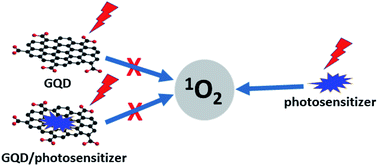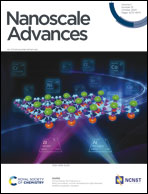Graphene quantum dots in photodynamic therapy†
Abstract
Graphene quantum dots (GQDs) have shown great promise in a variety of medical applications. Recently, it has been found that GQDs are also beneficial for photodynamic therapy (PDT). However, the findings of GQDs as PDT agents have been controversial in the literature. Herein, we investigate the photoactivity of single-atomic-layered GQDs by examining their ability to generate singlet oxygen (1O2) under irradiation and their effects on the photoactivity of photosensitizers. We demonstrate that the GQDs with lateral sizes of ∼5 or 20 nm are photo-inactive for they cannot generate 1O2 under irradiation of either a 660 nm laser (105 mW cm−2) or a halogen light. Moreover, the GQDs inhibit the photoactivity of two classical photosensitizers, namely, methylene blue and methylene violet. The stronger interaction between the GQDs and the photosensitizer results in greater inhibition of GQDs. Besides, the large-sized GQDs exhibit stronger inhibition than the small-sized GQDs. The inhibitory effect of the GQDs on the photoactivity of photosensitizers is consistent with their photo-cytotoxicity. These results indicate that the single-atomic-layered GQDs are not potential PDT agents, but they may be helpful for photosensitizers by delivering them into the cells. The discrepancy between the current work and the literature is probably associated with the GQDs used.



 Please wait while we load your content...
Please wait while we load your content...